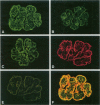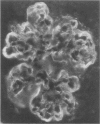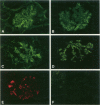Abstract
Massive glomerular deposits of C3 and the terminal C5b-9 complement complex (TCC), but no immune complex deposits were detected by immunofluorescence in porcine membranoproliferative glomerulonephritis type II. TCC deposits were always observed with concomitant deposits of vitronectin (S-protein) in membranoproliferative glomerulonephritis, in contrast to a piglet with mesangial glomerulopathy where TCC was present without vitronectin co-deposition. Enzyme immunoassays revealed extensive systemic complement activation in 1-week-old affected piglets, observed by low plasma C3 (about 5% of normal) and high plasma TCC (about 10 x normal). Affected piglets revealed some plasma complement activation already at birth, 3 to 4 weeks before recognizable clinical disease. It is concluded that porcine membranoproliferative glomerulonephritis represents a nonimmune complex-mediated glomerulonephritis caused by unrestricted systemic complement activation with C3 consumption, TCC formation, and glomerular trapping of complement activation products. A pathogenetic mechanism of a defective or missing complement regulation protein is suggested.
Full text
PDF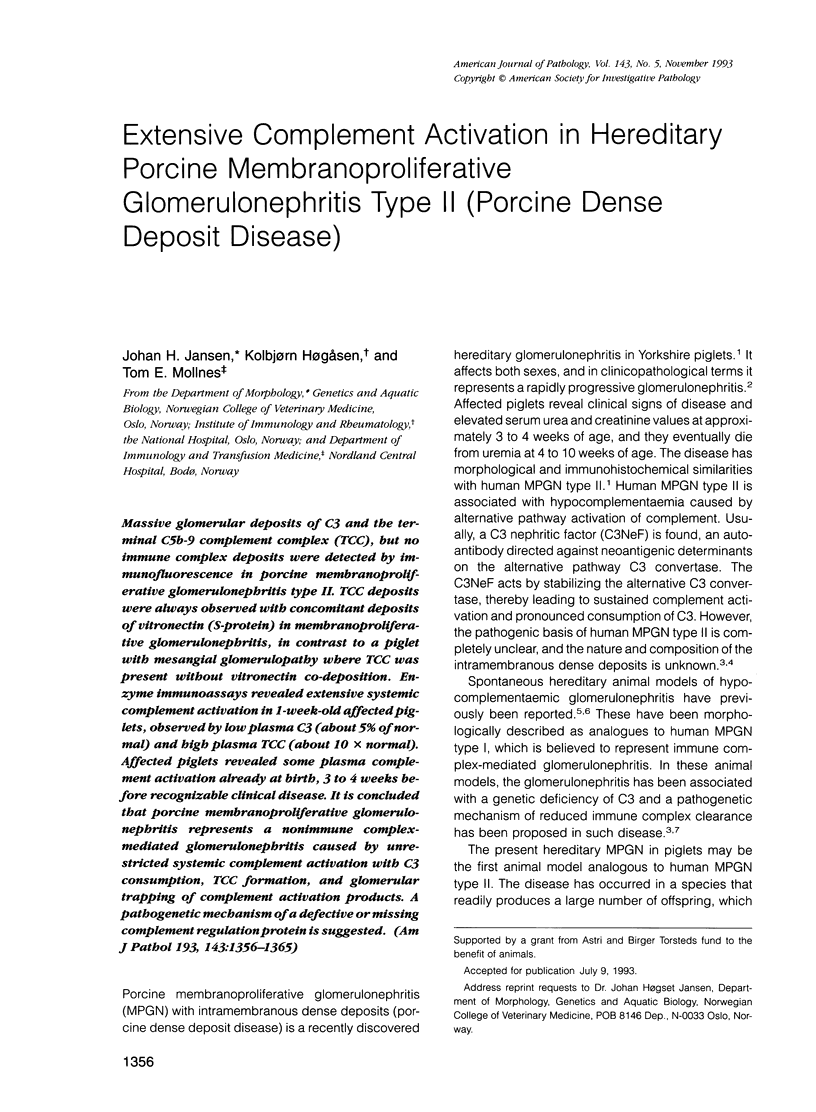
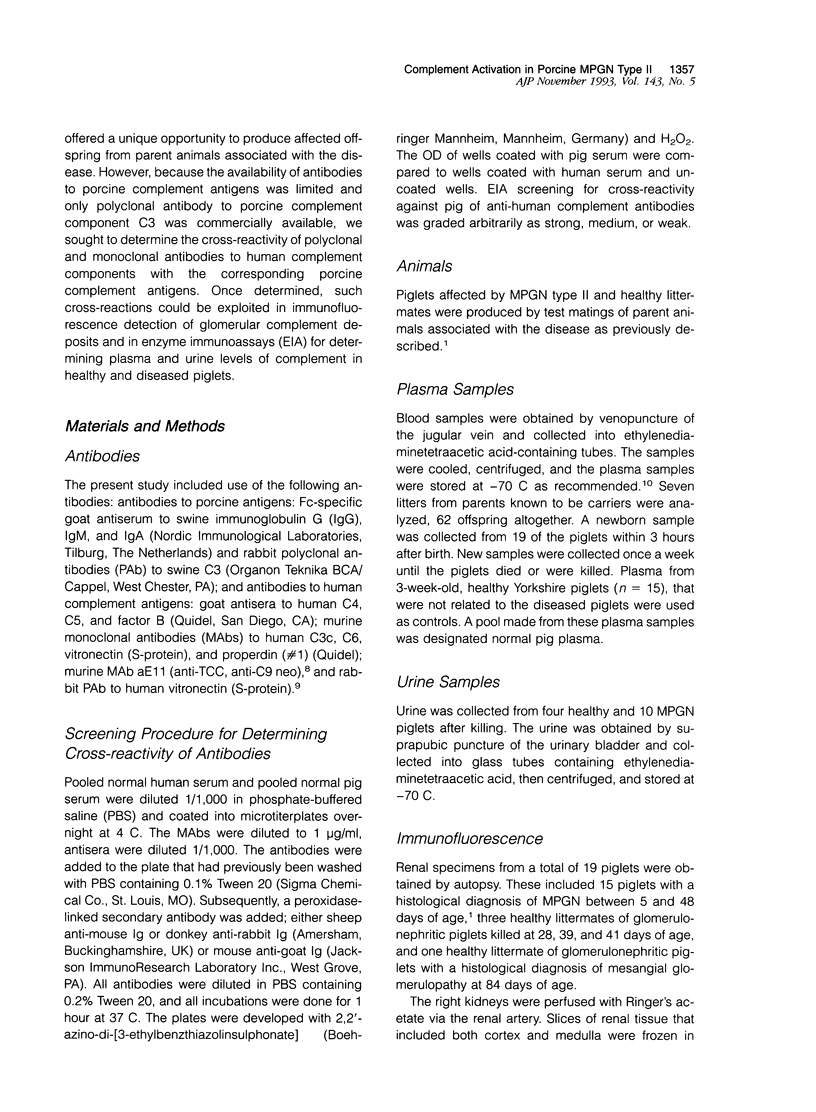
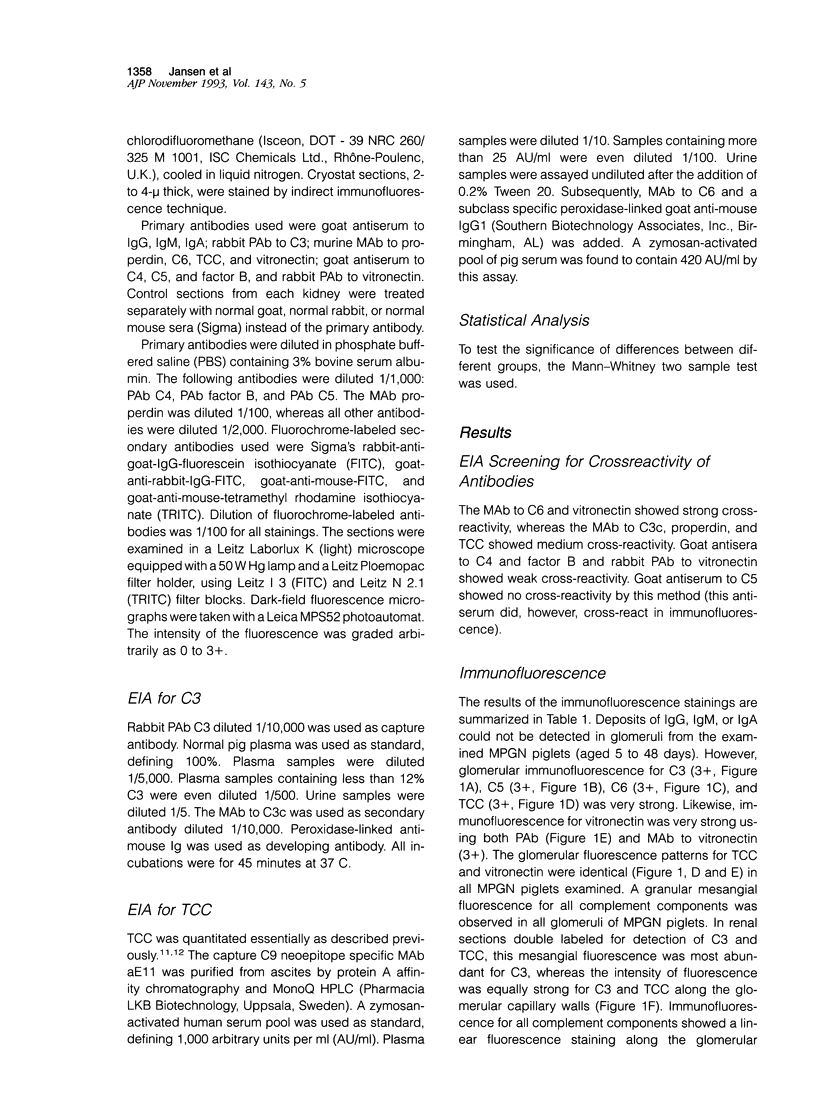
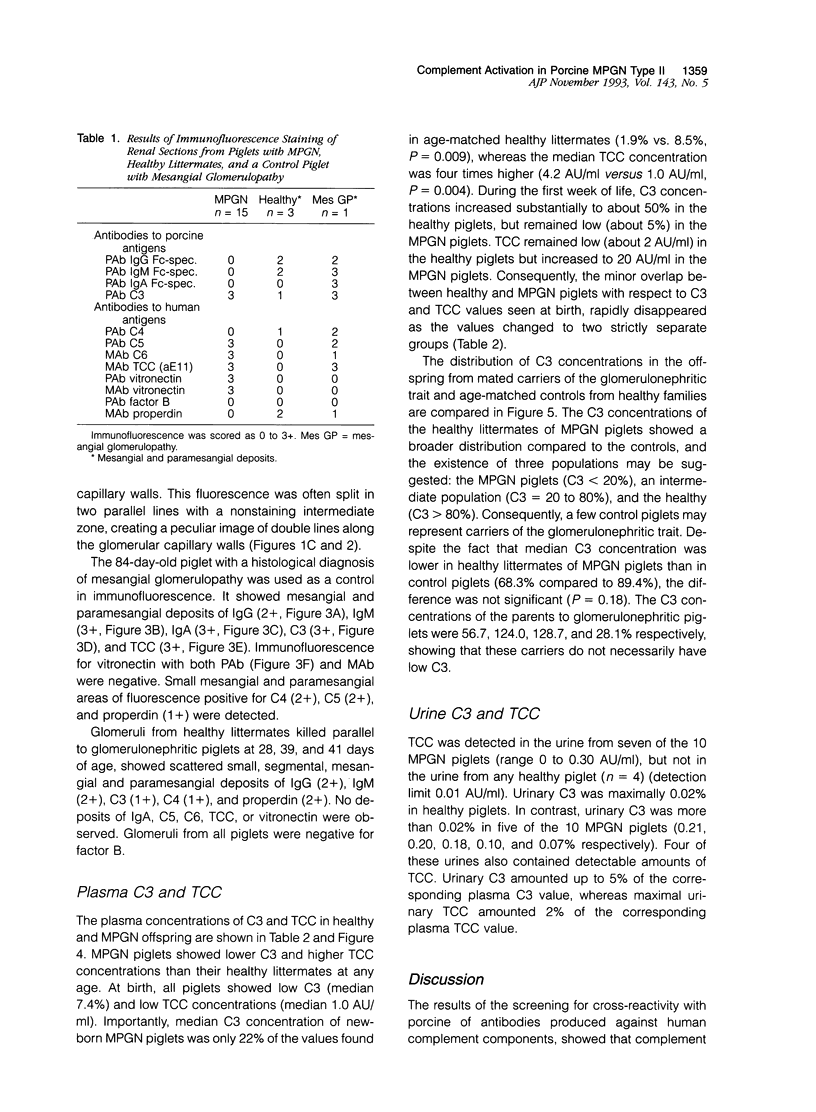
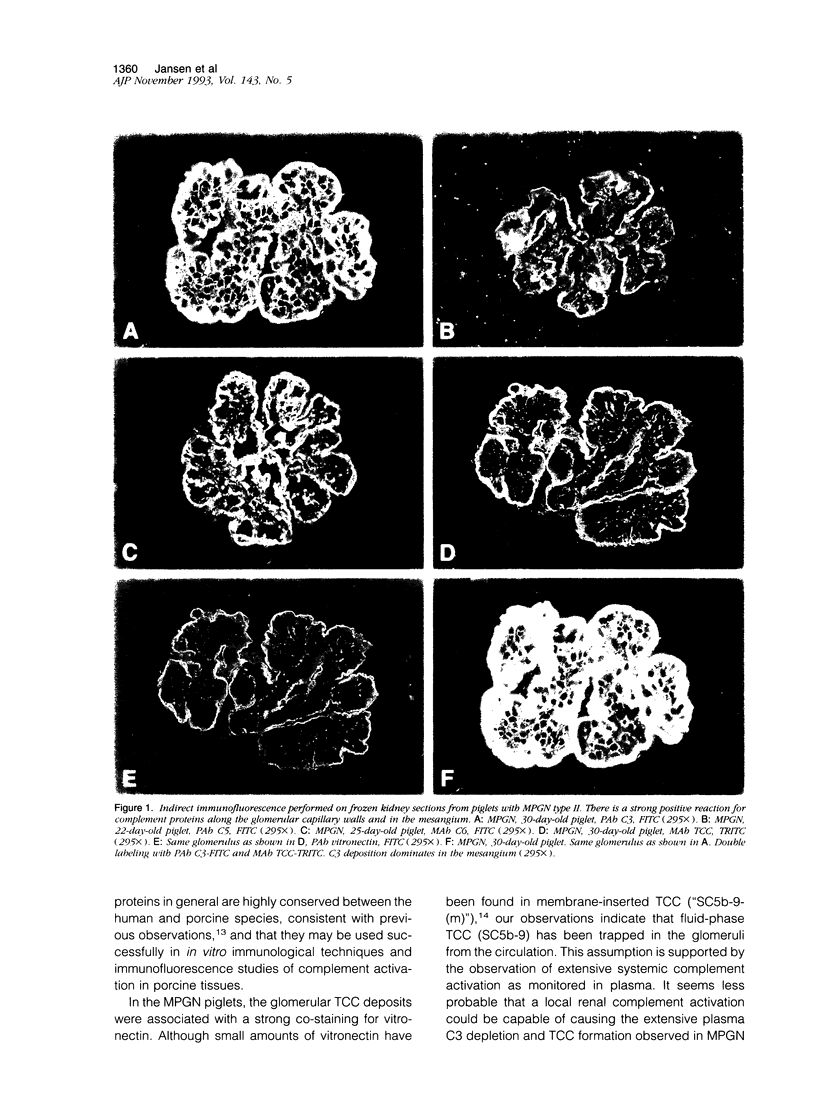
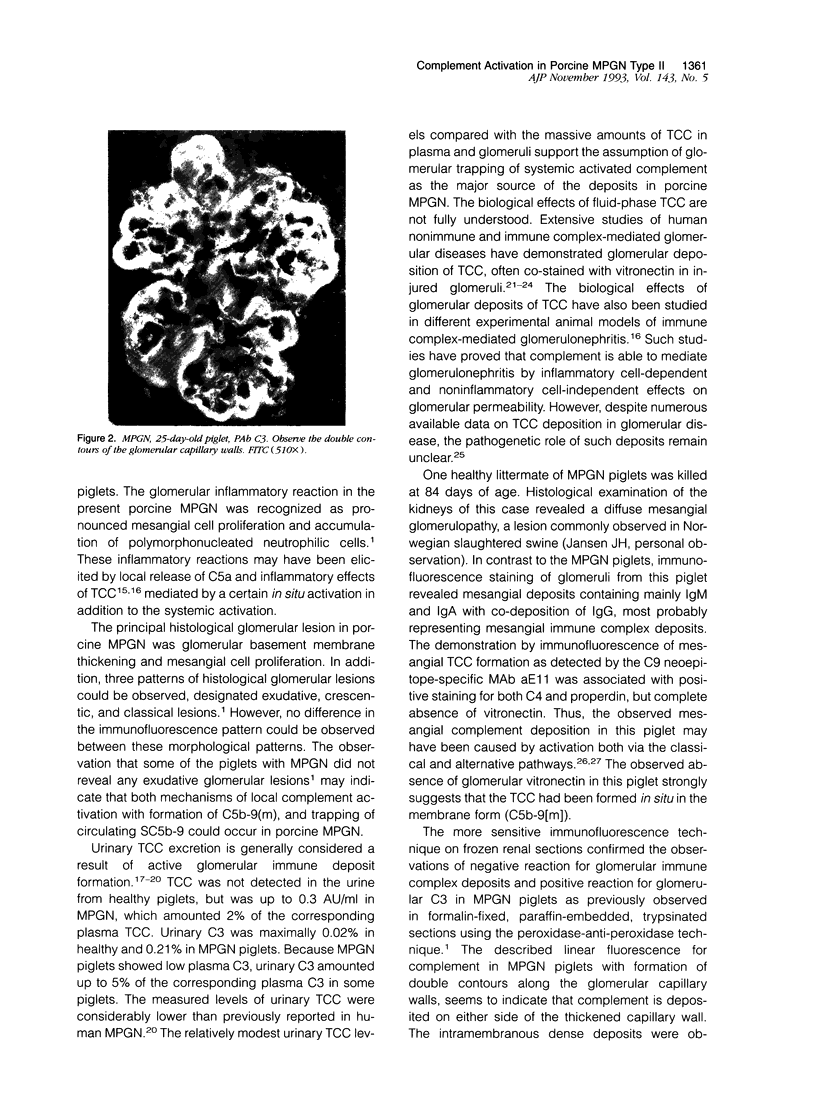
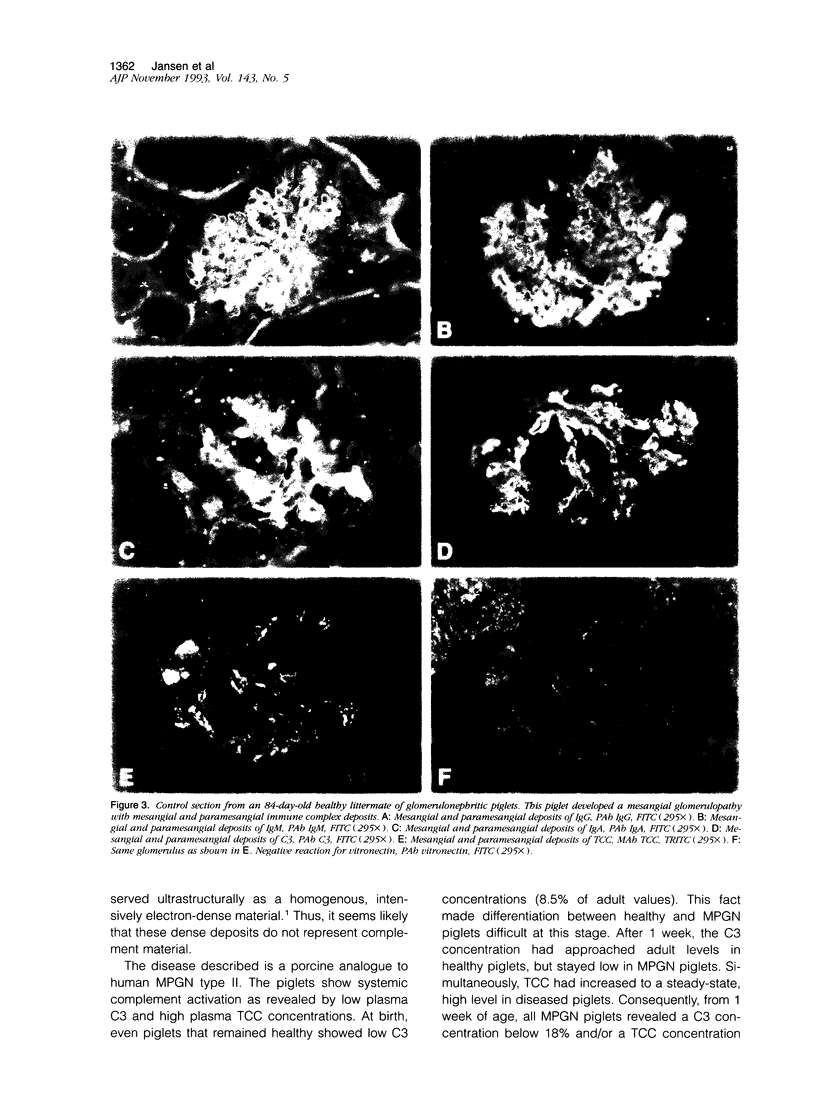
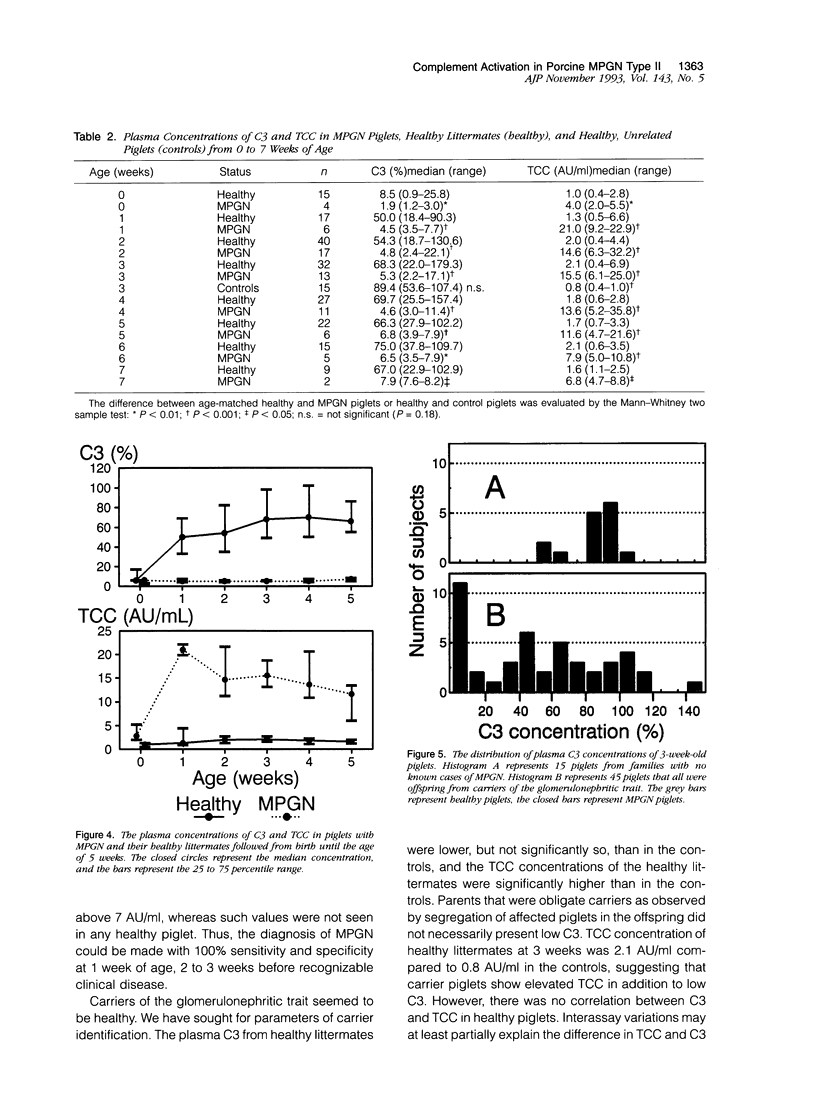
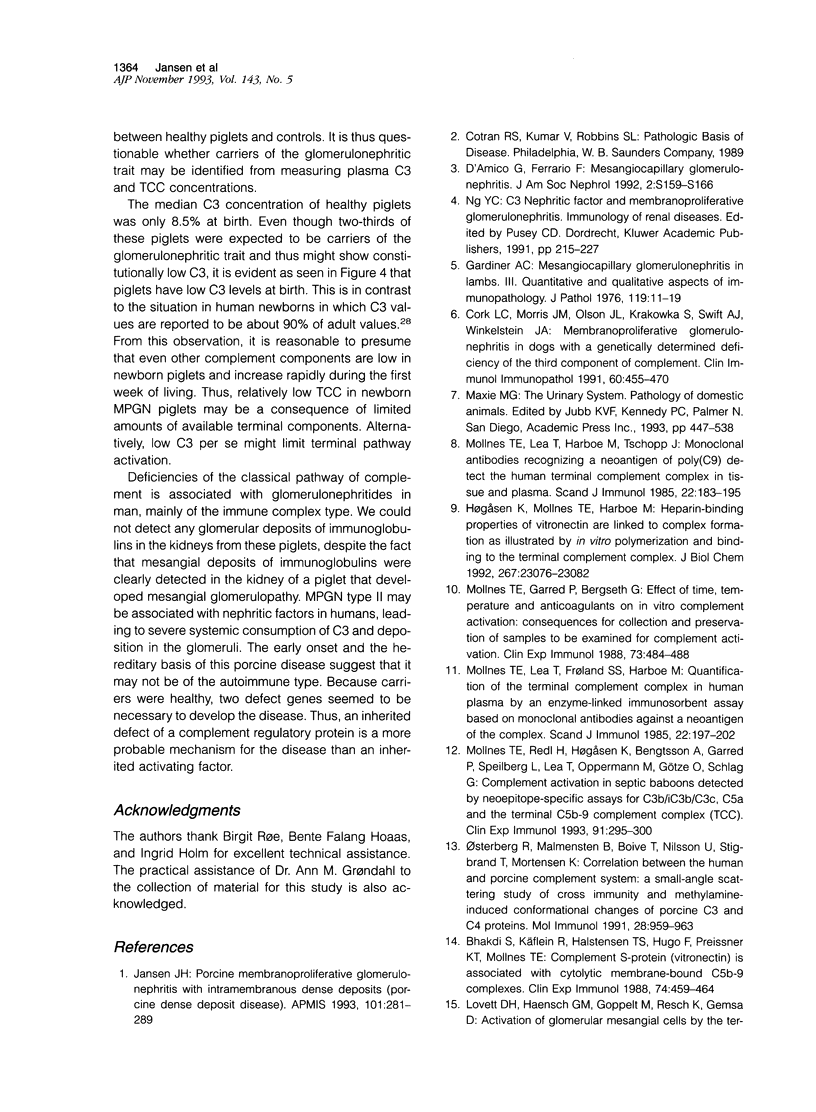
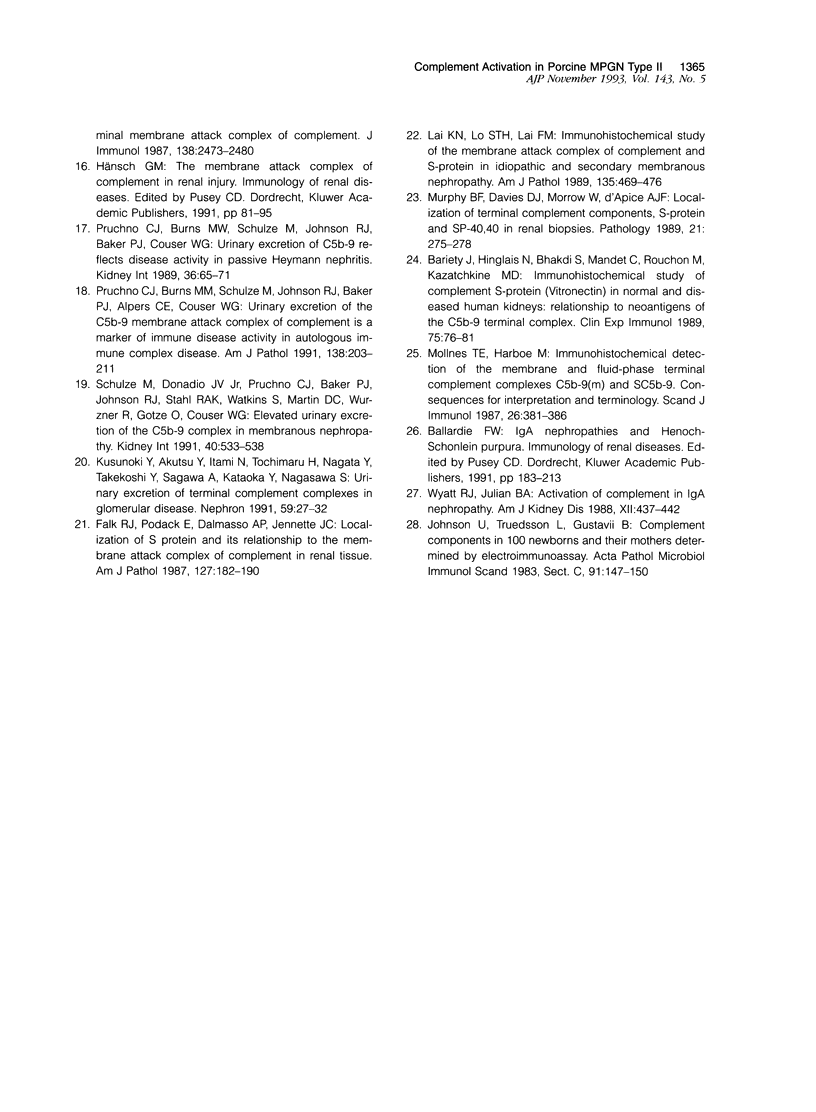
Images in this article
Selected References
These references are in PubMed. This may not be the complete list of references from this article.
- Bariety J., Hinglais N., Bhakdi S., Mandet C., Rouchon M., Kazatchkine M. D. Immunohistochemical study of complement S protein (Vitronectin) in normal and diseased human kidneys: relationship to neoantigens of the C5b-9 terminal complex. Clin Exp Immunol. 1989 Jan;75(1):76–81. [PMC free article] [PubMed] [Google Scholar]
- Bhakdi S., Käflein R., Halstensen T. S., Hugo F., Preissner K. T., Mollnes T. E. Complement S-protein (vitronectin) is associated with cytolytic membrane-bound C5b-9 complexes. Clin Exp Immunol. 1988 Dec;74(3):459–464. [PMC free article] [PubMed] [Google Scholar]
- Cork L. C., Morris J. M., Olson J. L., Krakowka S., Swift A. J., Winkelstein J. A. Membranoproliferative glomerulonephritis in dogs with a genetically determined deficiency of the third component of complement. Clin Immunol Immunopathol. 1991 Sep;60(3):455–470. doi: 10.1016/0090-1229(91)90101-f. [DOI] [PubMed] [Google Scholar]
- D'Amico G., Ferrario F. Mesangiocapillary glomerulonephritis. J Am Soc Nephrol. 1992 Apr;2(10 Suppl):S159–S166. doi: 10.1681/ASN.V210s159. [DOI] [PubMed] [Google Scholar]
- Falk R. J., Podack E., Dalmasso A. P., Jennette J. C. Localization of S protein and its relationship to the membrane attack complex of complement in renal tissue. Am J Pathol. 1987 Apr;127(1):182–190. [PMC free article] [PubMed] [Google Scholar]
- Gardiner A. C. Mesangiocapillary glomerulonephritis in lambs. III. Quantitative and qualitative aspects of immunopathology. J Pathol. 1976 May;119(1):11–19. doi: 10.1002/path.1711190104. [DOI] [PubMed] [Google Scholar]
- Høgåsen K., Mollnes T. E., Harboe M. Heparin-binding properties of vitronectin are linked to complex formation as illustrated by in vitro polymerization and binding to the terminal complement complex. J Biol Chem. 1992 Nov 15;267(32):23076–23082. [PubMed] [Google Scholar]
- Jansen J. H. Porcine membranoproliferative glomerulonephritis with intramembranous dense deposits (porcine dense deposit disease). APMIS. 1993 Apr;101(4):281–289. doi: 10.1111/j.1699-0463.1993.tb00112.x. [DOI] [PubMed] [Google Scholar]
- Johnson U., Truedsson L., Gustavii B. Complement components in 100 newborns and their mothers determined by electroimmunoassay. Acta Pathol Microbiol Immunol Scand C. 1983 Apr;91(2):147–150. [PubMed] [Google Scholar]
- Kusunoki Y., Akutsu Y., Itami N., Tochimaru H., Nagata Y., Takekoshi Y., Sagawa A., Kataoka Y., Nagasawa S. Urinary excretion of terminal complement complexes in glomerular disease. Nephron. 1991;59(1):27–32. doi: 10.1159/000186513. [DOI] [PubMed] [Google Scholar]
- Lai K. N., Lo S. T., Lai F. M. Immunohistochemical study of the membrane attack complex of complement and S-protein in idiopathic and secondary membranous nephropathy. Am J Pathol. 1989 Sep;135(3):469–476. [PMC free article] [PubMed] [Google Scholar]
- Mollnes T. E., Garred P., Bergseth G. Effect of time, temperature and anticoagulants on in vitro complement activation: consequences for collection and preservation of samples to be examined for complement activation. Clin Exp Immunol. 1988 Sep;73(3):484–488. [PMC free article] [PubMed] [Google Scholar]
- Mollnes T. E., Harboe M. Immunohistochemical detection of the membrane and fluid-phase terminal complement complexes C5b-9(m) and SC5b-9. Consequences for interpretation and terminology. Scand J Immunol. 1987 Oct;26(4):381–386. doi: 10.1111/j.1365-3083.1987.tb02270.x. [DOI] [PubMed] [Google Scholar]
- Mollnes T. E., Lea T., Frøland S. S., Harboe M. Quantification of the terminal complement complex in human plasma by an enzyme-linked immunosorbent assay based on monoclonal antibodies against a neoantigen of the complex. Scand J Immunol. 1985 Aug;22(2):197–202. doi: 10.1111/j.1365-3083.1985.tb01871.x. [DOI] [PubMed] [Google Scholar]
- Mollnes T. E., Lea T., Harboe M., Tschopp J. Monoclonal antibodies recognizing a neoantigen of poly(C9) detect the human terminal complement complex in tissue and plasma. Scand J Immunol. 1985 Aug;22(2):183–195. doi: 10.1111/j.1365-3083.1985.tb01870.x. [DOI] [PubMed] [Google Scholar]
- Mollnes T. E., Redl H., Høgåsen K., Bengtsson A., Garred P., Speilberg L., Lea T., Oppermann M., Götze O., Schlag G. Complement activation in septic baboons detected by neoepitope-specific assays for C3b/iC3b/C3c, C5a and the terminal C5b-9 complement complex (TCC). Clin Exp Immunol. 1993 Feb;91(2):295–300. doi: 10.1111/j.1365-2249.1993.tb05898.x. [DOI] [PMC free article] [PubMed] [Google Scholar]
- Murphy B. F., Davies D. J., Morrow W., d'Apice A. J. Localization of terminal complement components S-protein and SP-40,40 in renal biopsies. Pathology. 1989 Oct;21(4):275–278. doi: 10.3109/00313028909061073. [DOI] [PubMed] [Google Scholar]
- Osterberg R., Malmensten B., Boive T., Nilsson U., Stigbrand T., Mortensen K. Correlation between the human and porcine complement system: a small-angle scattering study of cross immunity and methylamine-induced conformational changes of porcine C3 and C4 proteins. Mol Immunol. 1991 Sep;28(9):959–963. doi: 10.1016/0161-5890(91)90181-i. [DOI] [PubMed] [Google Scholar]
- Pruchno C. J., Burns M. M., Schulze M., Johnson R. J., Baker P. J., Alpers C. E., Couser W. G. Urinary excretion of the C5b-9 membrane attack complex of complement is a marker of immune disease activity in autologous immune complex nephritis. Am J Pathol. 1991 Jan;138(1):203–211. [PMC free article] [PubMed] [Google Scholar]
- Pruchno C. J., Burns M. W., Schulze M., Johnson R. J., Baker P. J., Couser W. G. Urinary excretion of C5b-9 reflects disease activity in passive Heymann nephritis. Kidney Int. 1989 Jul;36(1):65–71. doi: 10.1038/ki.1989.162. [DOI] [PubMed] [Google Scholar]
- Schulze M., Donadio J. V., Jr, Pruchno C. J., Baker P. J., Johnson R. J., Stahl R. A., Watkins S., Martin D. C., Wurzner R., Gotze O. Elevated urinary excretion of the C5b-9 complex in membranous nephropathy. Kidney Int. 1991 Sep;40(3):533–538. doi: 10.1038/ki.1991.242. [DOI] [PubMed] [Google Scholar]
- Wyatt R. J., Julian B. A. Activation of complement in IgA nephropathy. Am J Kidney Dis. 1988 Nov;12(5):437–442. doi: 10.1016/s0272-6386(88)80042-8. [DOI] [PubMed] [Google Scholar]



